The Importance of Mackinder's Heartland Theory in Geopolitics
VerifiedAdded on 2023/01/10
|12
|3279
|45
Essay
AI Summary
This essay delves into the significance of Mackinder's Heartland theory, a geopolitical concept analyzing a country's economic and political success based on its geography. It explores the theory's relevance in the 21st century, examining factors that determine the Heartland and its fluctuations. The essay discusses the application of Mackinder's ideas in modern times, analyzing how they assist in understanding a nation's success in the context of geography. It also considers whether China should be considered the new heartland, due to changes in international systems. The essay further highlights the factors that determine the Heartland, including international relations, government practices, and economic stability. The essay concludes by discussing the geopolitical conditions of the early twenty-first century and their impact on the regional structural principles of the Eurasian continent.

Essay
Paraphrase This Document
Need a fresh take? Get an instant paraphrase of this document with our AI Paraphraser
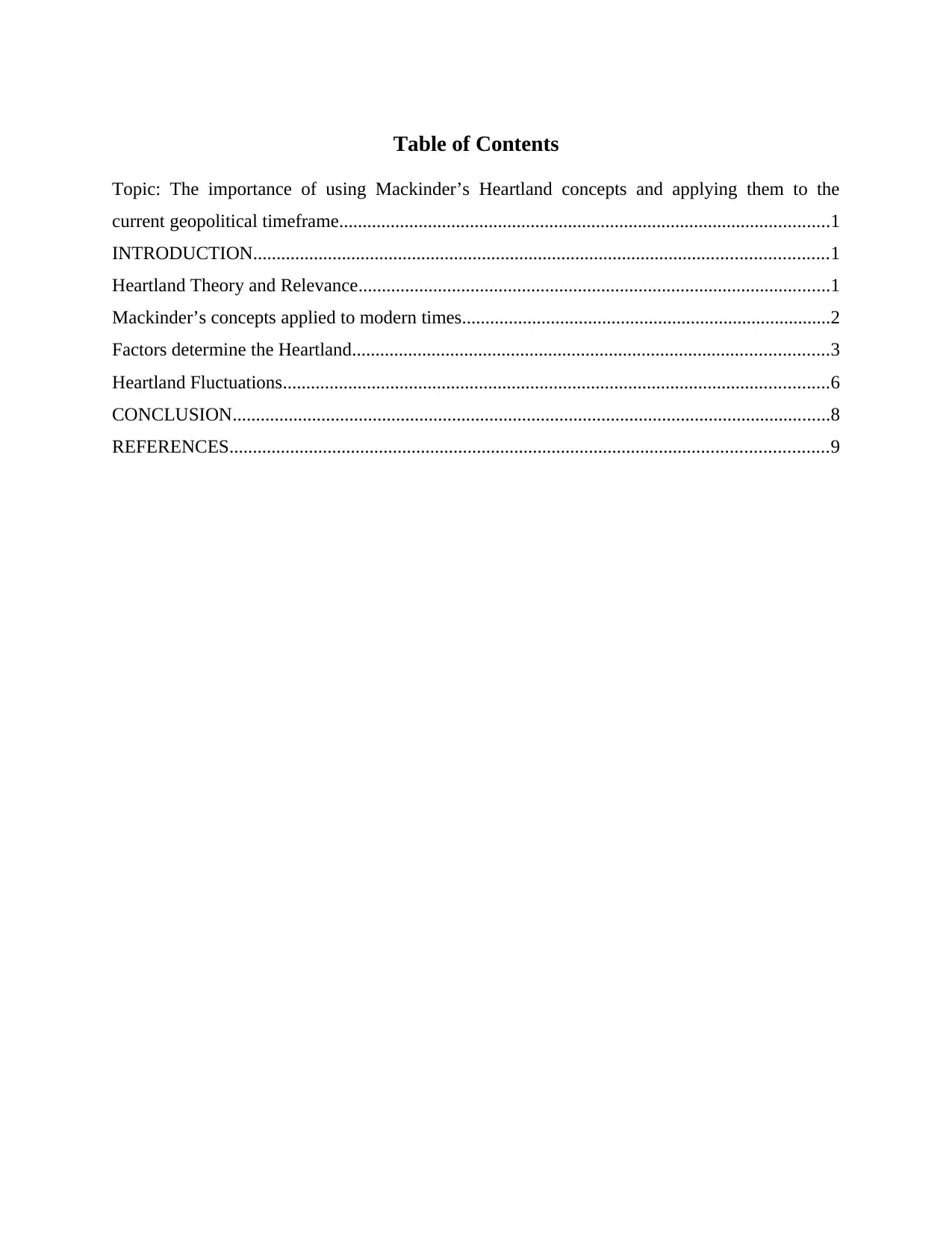
Table of Contents
Topic: The importance of using Mackinder’s Heartland concepts and applying them to the
current geopolitical timeframe.........................................................................................................1
INTRODUCTION...........................................................................................................................1
Heartland Theory and Relevance.....................................................................................................1
Mackinder’s concepts applied to modern times...............................................................................2
Factors determine the Heartland......................................................................................................3
Heartland Fluctuations.....................................................................................................................6
CONCLUSION................................................................................................................................8
REFERENCES................................................................................................................................9
Topic: The importance of using Mackinder’s Heartland concepts and applying them to the
current geopolitical timeframe.........................................................................................................1
INTRODUCTION...........................................................................................................................1
Heartland Theory and Relevance.....................................................................................................1
Mackinder’s concepts applied to modern times...............................................................................2
Factors determine the Heartland......................................................................................................3
Heartland Fluctuations.....................................................................................................................6
CONCLUSION................................................................................................................................8
REFERENCES................................................................................................................................9

⊘ This is a preview!⊘
Do you want full access?
Subscribe today to unlock all pages.

Trusted by 1+ million students worldwide
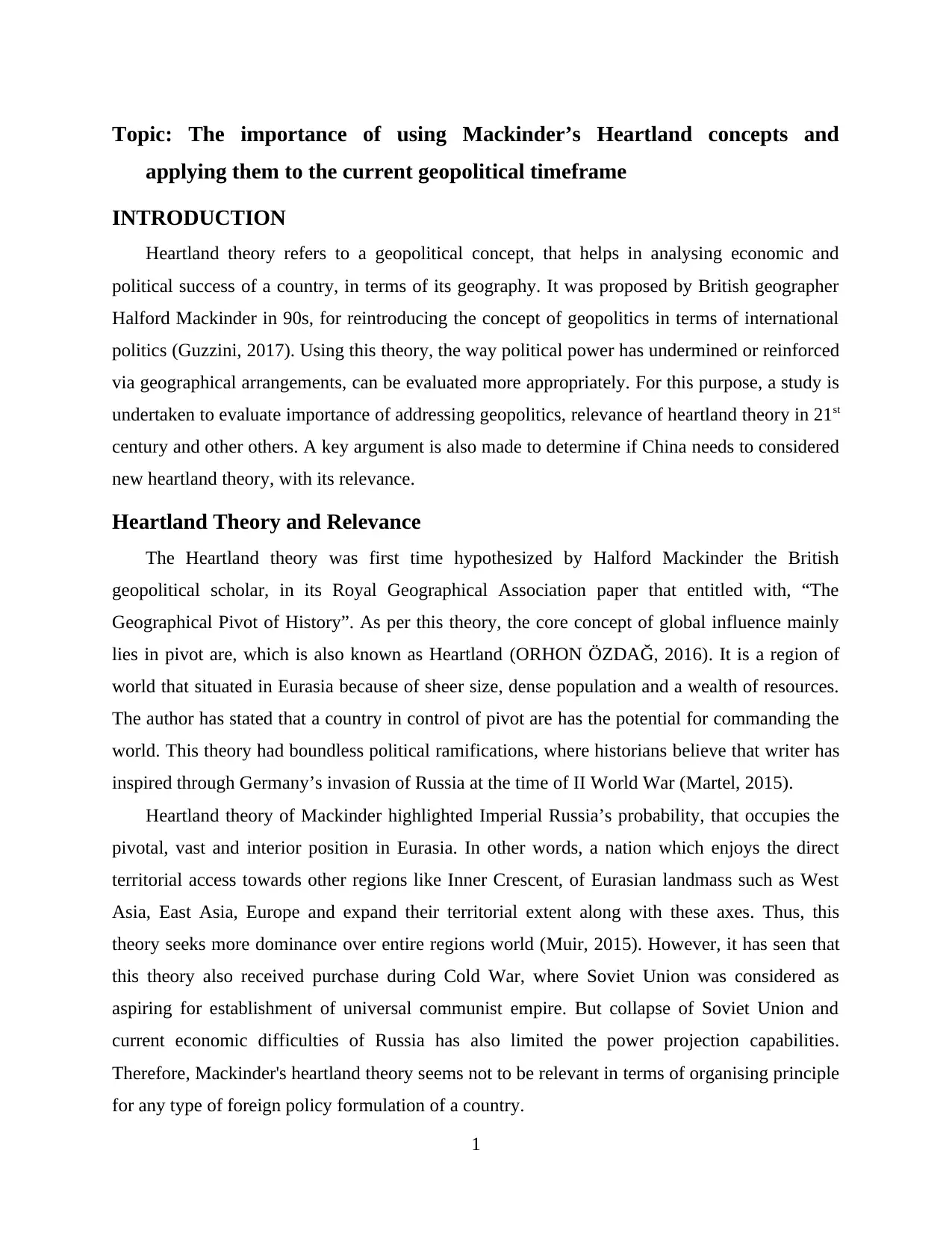
Topic: The importance of using Mackinder’s Heartland concepts and
applying them to the current geopolitical timeframe
INTRODUCTION
Heartland theory refers to a geopolitical concept, that helps in analysing economic and
political success of a country, in terms of its geography. It was proposed by British geographer
Halford Mackinder in 90s, for reintroducing the concept of geopolitics in terms of international
politics (Guzzini, 2017). Using this theory, the way political power has undermined or reinforced
via geographical arrangements, can be evaluated more appropriately. For this purpose, a study is
undertaken to evaluate importance of addressing geopolitics, relevance of heartland theory in 21st
century and other others. A key argument is also made to determine if China needs to considered
new heartland theory, with its relevance.
Heartland Theory and Relevance
The Heartland theory was first time hypothesized by Halford Mackinder the British
geopolitical scholar, in its Royal Geographical Association paper that entitled with, “The
Geographical Pivot of History”. As per this theory, the core concept of global influence mainly
lies in pivot are, which is also known as Heartland (ORHON ÖZDAĞ, 2016). It is a region of
world that situated in Eurasia because of sheer size, dense population and a wealth of resources.
The author has stated that a country in control of pivot are has the potential for commanding the
world. This theory had boundless political ramifications, where historians believe that writer has
inspired through Germany’s invasion of Russia at the time of II World War (Martel, 2015).
Heartland theory of Mackinder highlighted Imperial Russia’s probability, that occupies the
pivotal, vast and interior position in Eurasia. In other words, a nation which enjoys the direct
territorial access towards other regions like Inner Crescent, of Eurasian landmass such as West
Asia, East Asia, Europe and expand their territorial extent along with these axes. Thus, this
theory seeks more dominance over entire regions world (Muir, 2015). However, it has seen that
this theory also received purchase during Cold War, where Soviet Union was considered as
aspiring for establishment of universal communist empire. But collapse of Soviet Union and
current economic difficulties of Russia has also limited the power projection capabilities.
Therefore, Mackinder's heartland theory seems not to be relevant in terms of organising principle
for any type of foreign policy formulation of a country.
1
applying them to the current geopolitical timeframe
INTRODUCTION
Heartland theory refers to a geopolitical concept, that helps in analysing economic and
political success of a country, in terms of its geography. It was proposed by British geographer
Halford Mackinder in 90s, for reintroducing the concept of geopolitics in terms of international
politics (Guzzini, 2017). Using this theory, the way political power has undermined or reinforced
via geographical arrangements, can be evaluated more appropriately. For this purpose, a study is
undertaken to evaluate importance of addressing geopolitics, relevance of heartland theory in 21st
century and other others. A key argument is also made to determine if China needs to considered
new heartland theory, with its relevance.
Heartland Theory and Relevance
The Heartland theory was first time hypothesized by Halford Mackinder the British
geopolitical scholar, in its Royal Geographical Association paper that entitled with, “The
Geographical Pivot of History”. As per this theory, the core concept of global influence mainly
lies in pivot are, which is also known as Heartland (ORHON ÖZDAĞ, 2016). It is a region of
world that situated in Eurasia because of sheer size, dense population and a wealth of resources.
The author has stated that a country in control of pivot are has the potential for commanding the
world. This theory had boundless political ramifications, where historians believe that writer has
inspired through Germany’s invasion of Russia at the time of II World War (Martel, 2015).
Heartland theory of Mackinder highlighted Imperial Russia’s probability, that occupies the
pivotal, vast and interior position in Eurasia. In other words, a nation which enjoys the direct
territorial access towards other regions like Inner Crescent, of Eurasian landmass such as West
Asia, East Asia, Europe and expand their territorial extent along with these axes. Thus, this
theory seeks more dominance over entire regions world (Muir, 2015). However, it has seen that
this theory also received purchase during Cold War, where Soviet Union was considered as
aspiring for establishment of universal communist empire. But collapse of Soviet Union and
current economic difficulties of Russia has also limited the power projection capabilities.
Therefore, Mackinder's heartland theory seems not to be relevant in terms of organising principle
for any type of foreign policy formulation of a country.
1
Paraphrase This Document
Need a fresh take? Get an instant paraphrase of this document with our AI Paraphraser
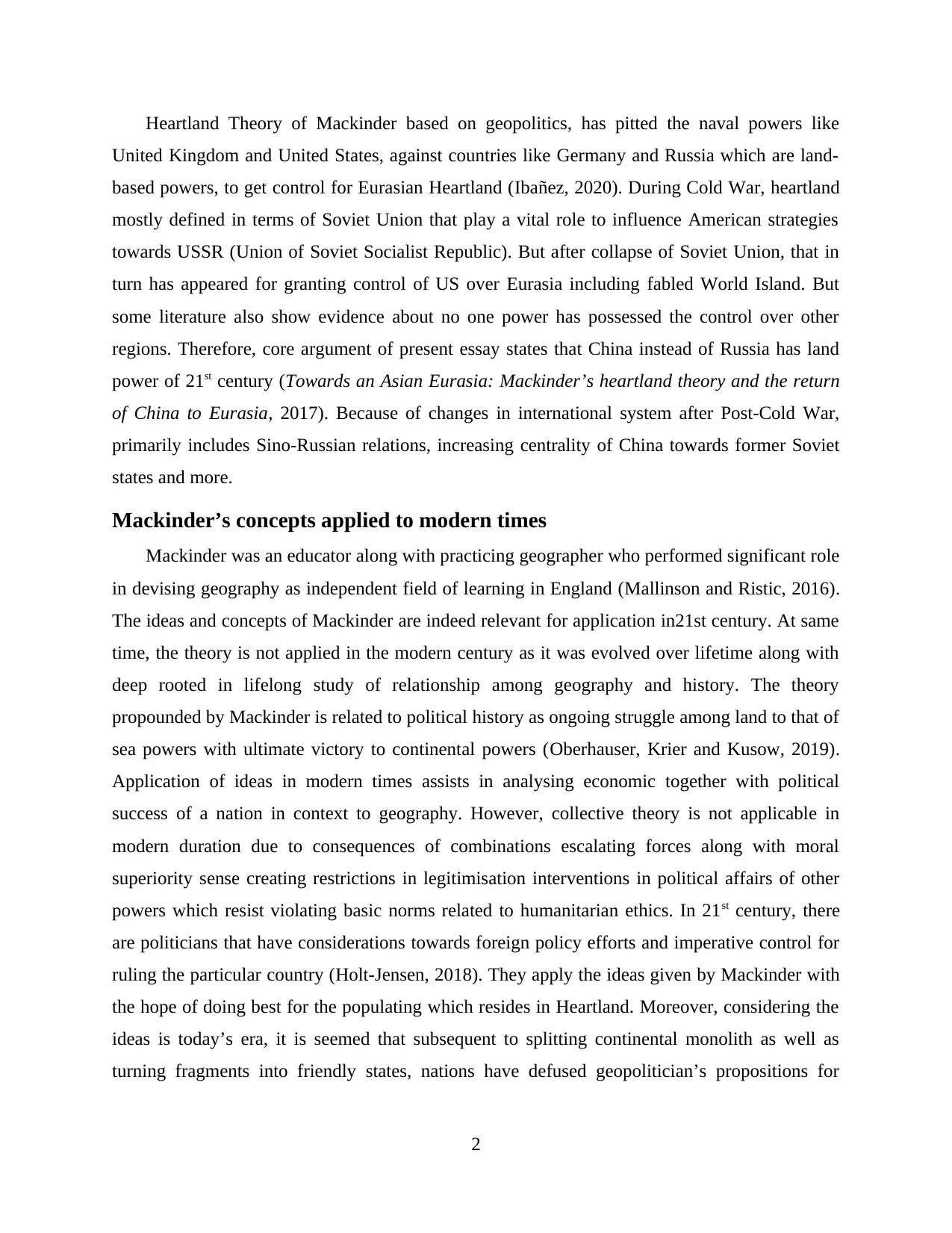
Heartland Theory of Mackinder based on geopolitics, has pitted the naval powers like
United Kingdom and United States, against countries like Germany and Russia which are land-
based powers, to get control for Eurasian Heartland (Ibañez, 2020). During Cold War, heartland
mostly defined in terms of Soviet Union that play a vital role to influence American strategies
towards USSR (Union of Soviet Socialist Republic). But after collapse of Soviet Union, that in
turn has appeared for granting control of US over Eurasia including fabled World Island. But
some literature also show evidence about no one power has possessed the control over other
regions. Therefore, core argument of present essay states that China instead of Russia has land
power of 21st century (Towards an Asian Eurasia: Mackinder’s heartland theory and the return
of China to Eurasia, 2017). Because of changes in international system after Post-Cold War,
primarily includes Sino-Russian relations, increasing centrality of China towards former Soviet
states and more.
Mackinder’s concepts applied to modern times
Mackinder was an educator along with practicing geographer who performed significant role
in devising geography as independent field of learning in England (Mallinson and Ristic, 2016).
The ideas and concepts of Mackinder are indeed relevant for application in21st century. At same
time, the theory is not applied in the modern century as it was evolved over lifetime along with
deep rooted in lifelong study of relationship among geography and history. The theory
propounded by Mackinder is related to political history as ongoing struggle among land to that of
sea powers with ultimate victory to continental powers (Oberhauser, Krier and Kusow, 2019).
Application of ideas in modern times assists in analysing economic together with political
success of a nation in context to geography. However, collective theory is not applicable in
modern duration due to consequences of combinations escalating forces along with moral
superiority sense creating restrictions in legitimisation interventions in political affairs of other
powers which resist violating basic norms related to humanitarian ethics. In 21st century, there
are politicians that have considerations towards foreign policy efforts and imperative control for
ruling the particular country (Holt-Jensen, 2018). They apply the ideas given by Mackinder with
the hope of doing best for the populating which resides in Heartland. Moreover, considering the
ideas is today’s era, it is seemed that subsequent to splitting continental monolith as well as
turning fragments into friendly states, nations have defused geopolitician’s propositions for
2
United Kingdom and United States, against countries like Germany and Russia which are land-
based powers, to get control for Eurasian Heartland (Ibañez, 2020). During Cold War, heartland
mostly defined in terms of Soviet Union that play a vital role to influence American strategies
towards USSR (Union of Soviet Socialist Republic). But after collapse of Soviet Union, that in
turn has appeared for granting control of US over Eurasia including fabled World Island. But
some literature also show evidence about no one power has possessed the control over other
regions. Therefore, core argument of present essay states that China instead of Russia has land
power of 21st century (Towards an Asian Eurasia: Mackinder’s heartland theory and the return
of China to Eurasia, 2017). Because of changes in international system after Post-Cold War,
primarily includes Sino-Russian relations, increasing centrality of China towards former Soviet
states and more.
Mackinder’s concepts applied to modern times
Mackinder was an educator along with practicing geographer who performed significant role
in devising geography as independent field of learning in England (Mallinson and Ristic, 2016).
The ideas and concepts of Mackinder are indeed relevant for application in21st century. At same
time, the theory is not applied in the modern century as it was evolved over lifetime along with
deep rooted in lifelong study of relationship among geography and history. The theory
propounded by Mackinder is related to political history as ongoing struggle among land to that of
sea powers with ultimate victory to continental powers (Oberhauser, Krier and Kusow, 2019).
Application of ideas in modern times assists in analysing economic together with political
success of a nation in context to geography. However, collective theory is not applicable in
modern duration due to consequences of combinations escalating forces along with moral
superiority sense creating restrictions in legitimisation interventions in political affairs of other
powers which resist violating basic norms related to humanitarian ethics. In 21st century, there
are politicians that have considerations towards foreign policy efforts and imperative control for
ruling the particular country (Holt-Jensen, 2018). They apply the ideas given by Mackinder with
the hope of doing best for the populating which resides in Heartland. Moreover, considering the
ideas is today’s era, it is seemed that subsequent to splitting continental monolith as well as
turning fragments into friendly states, nations have defused geopolitician’s propositions for
2
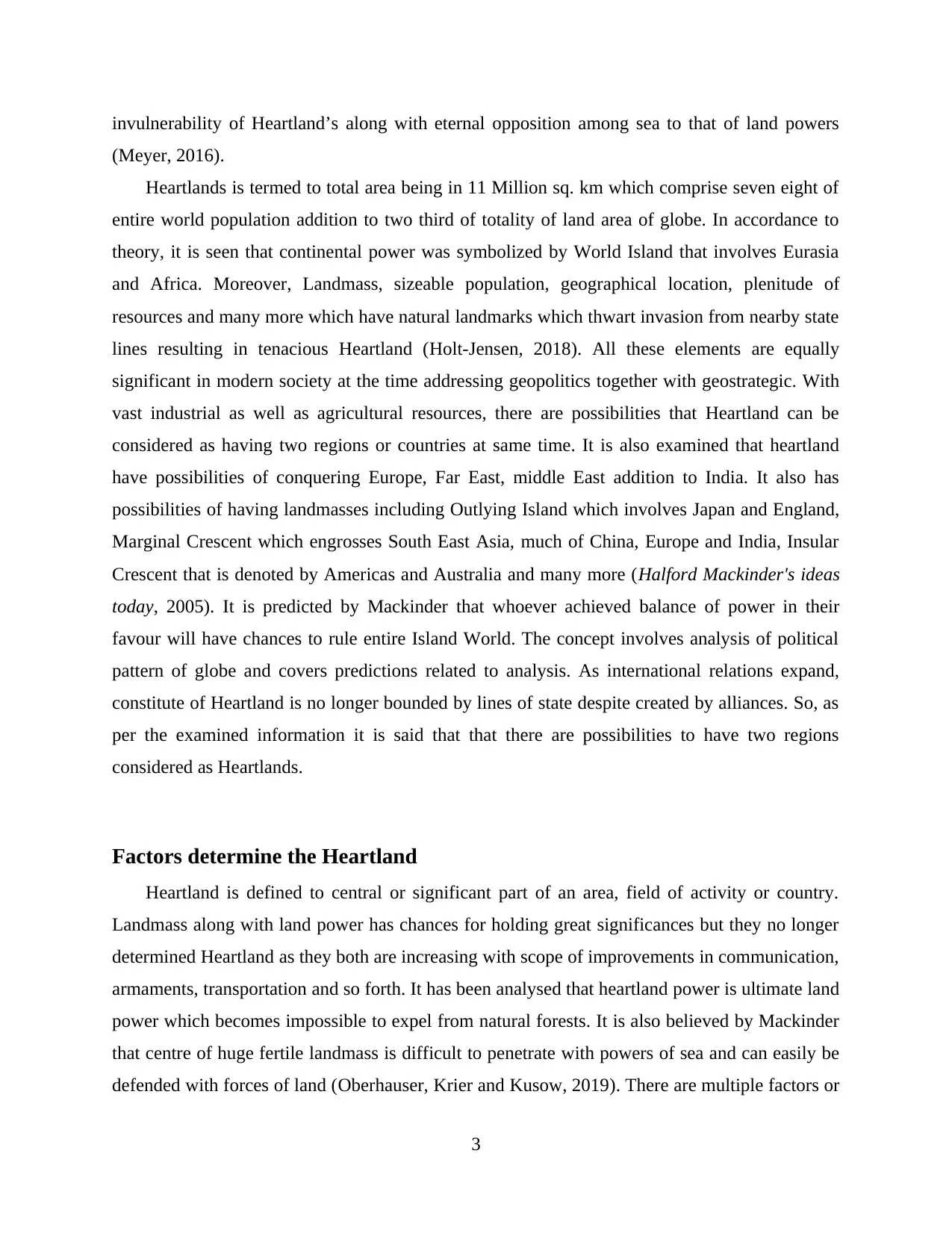
invulnerability of Heartland’s along with eternal opposition among sea to that of land powers
(Meyer, 2016).
Heartlands is termed to total area being in 11 Million sq. km which comprise seven eight of
entire world population addition to two third of totality of land area of globe. In accordance to
theory, it is seen that continental power was symbolized by World Island that involves Eurasia
and Africa. Moreover, Landmass, sizeable population, geographical location, plenitude of
resources and many more which have natural landmarks which thwart invasion from nearby state
lines resulting in tenacious Heartland (Holt-Jensen, 2018). All these elements are equally
significant in modern society at the time addressing geopolitics together with geostrategic. With
vast industrial as well as agricultural resources, there are possibilities that Heartland can be
considered as having two regions or countries at same time. It is also examined that heartland
have possibilities of conquering Europe, Far East, middle East addition to India. It also has
possibilities of having landmasses including Outlying Island which involves Japan and England,
Marginal Crescent which engrosses South East Asia, much of China, Europe and India, Insular
Crescent that is denoted by Americas and Australia and many more (Halford Mackinder's ideas
today, 2005). It is predicted by Mackinder that whoever achieved balance of power in their
favour will have chances to rule entire Island World. The concept involves analysis of political
pattern of globe and covers predictions related to analysis. As international relations expand,
constitute of Heartland is no longer bounded by lines of state despite created by alliances. So, as
per the examined information it is said that that there are possibilities to have two regions
considered as Heartlands.
Factors determine the Heartland
Heartland is defined to central or significant part of an area, field of activity or country.
Landmass along with land power has chances for holding great significances but they no longer
determined Heartland as they both are increasing with scope of improvements in communication,
armaments, transportation and so forth. It has been analysed that heartland power is ultimate land
power which becomes impossible to expel from natural forests. It is also believed by Mackinder
that centre of huge fertile landmass is difficult to penetrate with powers of sea and can easily be
defended with forces of land (Oberhauser, Krier and Kusow, 2019). There are multiple factors or
3
(Meyer, 2016).
Heartlands is termed to total area being in 11 Million sq. km which comprise seven eight of
entire world population addition to two third of totality of land area of globe. In accordance to
theory, it is seen that continental power was symbolized by World Island that involves Eurasia
and Africa. Moreover, Landmass, sizeable population, geographical location, plenitude of
resources and many more which have natural landmarks which thwart invasion from nearby state
lines resulting in tenacious Heartland (Holt-Jensen, 2018). All these elements are equally
significant in modern society at the time addressing geopolitics together with geostrategic. With
vast industrial as well as agricultural resources, there are possibilities that Heartland can be
considered as having two regions or countries at same time. It is also examined that heartland
have possibilities of conquering Europe, Far East, middle East addition to India. It also has
possibilities of having landmasses including Outlying Island which involves Japan and England,
Marginal Crescent which engrosses South East Asia, much of China, Europe and India, Insular
Crescent that is denoted by Americas and Australia and many more (Halford Mackinder's ideas
today, 2005). It is predicted by Mackinder that whoever achieved balance of power in their
favour will have chances to rule entire Island World. The concept involves analysis of political
pattern of globe and covers predictions related to analysis. As international relations expand,
constitute of Heartland is no longer bounded by lines of state despite created by alliances. So, as
per the examined information it is said that that there are possibilities to have two regions
considered as Heartlands.
Factors determine the Heartland
Heartland is defined to central or significant part of an area, field of activity or country.
Landmass along with land power has chances for holding great significances but they no longer
determined Heartland as they both are increasing with scope of improvements in communication,
armaments, transportation and so forth. It has been analysed that heartland power is ultimate land
power which becomes impossible to expel from natural forests. It is also believed by Mackinder
that centre of huge fertile landmass is difficult to penetrate with powers of sea and can easily be
defended with forces of land (Oberhauser, Krier and Kusow, 2019). There are multiple factors or
3
⊘ This is a preview!⊘
Do you want full access?
Subscribe today to unlock all pages.

Trusted by 1+ million students worldwide

variables which contribute in determining or depicting a Heartland. One of the factors is
International relations. The patterns of international relations among countries or regions
determined about Heartland. It is majorly concerned with international affairs along with
relations among nations that states about political as well as economic success by geography
(Guzzini, 2017). The relations between different countries which are underpinned as well as
reinforced through geographical arrangements describes about the concept. Moreover,
geopolitics along with the application through geostrategic is controversial area related to
international relations. The practice for obtaining resources and coming with imperial policies of
great industrial powers is key element in heartland through which significance of land powers
and masses are identified properly.
The other factor that determines Heartland is government practices. The practices
adopted by government authorities for pivot area and enhancing importance of invincible sea
powers. Guarantee self-sufficiency about food for nations dominating regions and developing
land masses and powers also assist in depicting about Heartland. In countries like China, India
and Middle east, government practices are for developing the areas and eradicating issues related
to geopolitics which defines about the term successfully (Meyer, 2016). Various practices
implemented by political systems related to overcome from continuous struggle among sea and
land powers with victory related to continental powers also one of the element that contributes
mainly for depicting a Heartland. It is also superficial as furthermost natural fortress on the globe
that is surrounded on all sides from geographical barriers (ORHON ÖZDAĞ, 2016).
Other factors that plays essential role in determining about heartland is economic stability. It
is described as fiscal system of a country which displays minor changes in output growth as well
as exhibits consistently low rate of inflation. The factor states about desirable position for
developed nation which is encouraged through policies along with actions of central bank. The
element has various effects on entire welfare of population along with countries through creating
an atmosphere wherein economic resources lose values as well as investment hinders or stop. At
global level, different countries have different ways to manage economic stability (Martel,
2015). For instance, US has economic stability as it keeps certain reforms at effective place that
demonstrates about Heartland. Certain policies adopted by nations for stable economy includes
fiscal stabilisers, flexible labour markets, monetary policy and so on. It is also seen that heartland
4
International relations. The patterns of international relations among countries or regions
determined about Heartland. It is majorly concerned with international affairs along with
relations among nations that states about political as well as economic success by geography
(Guzzini, 2017). The relations between different countries which are underpinned as well as
reinforced through geographical arrangements describes about the concept. Moreover,
geopolitics along with the application through geostrategic is controversial area related to
international relations. The practice for obtaining resources and coming with imperial policies of
great industrial powers is key element in heartland through which significance of land powers
and masses are identified properly.
The other factor that determines Heartland is government practices. The practices
adopted by government authorities for pivot area and enhancing importance of invincible sea
powers. Guarantee self-sufficiency about food for nations dominating regions and developing
land masses and powers also assist in depicting about Heartland. In countries like China, India
and Middle east, government practices are for developing the areas and eradicating issues related
to geopolitics which defines about the term successfully (Meyer, 2016). Various practices
implemented by political systems related to overcome from continuous struggle among sea and
land powers with victory related to continental powers also one of the element that contributes
mainly for depicting a Heartland. It is also superficial as furthermost natural fortress on the globe
that is surrounded on all sides from geographical barriers (ORHON ÖZDAĞ, 2016).
Other factors that plays essential role in determining about heartland is economic stability. It
is described as fiscal system of a country which displays minor changes in output growth as well
as exhibits consistently low rate of inflation. The factor states about desirable position for
developed nation which is encouraged through policies along with actions of central bank. The
element has various effects on entire welfare of population along with countries through creating
an atmosphere wherein economic resources lose values as well as investment hinders or stop. At
global level, different countries have different ways to manage economic stability (Martel,
2015). For instance, US has economic stability as it keeps certain reforms at effective place that
demonstrates about Heartland. Certain policies adopted by nations for stable economy includes
fiscal stabilisers, flexible labour markets, monetary policy and so on. It is also seen that heartland
4
Paraphrase This Document
Need a fresh take? Get an instant paraphrase of this document with our AI Paraphraser

economy performs better than the portrayed ideas which states that it adds jobs and also assist in
increasing outputs.
5
increasing outputs.
5
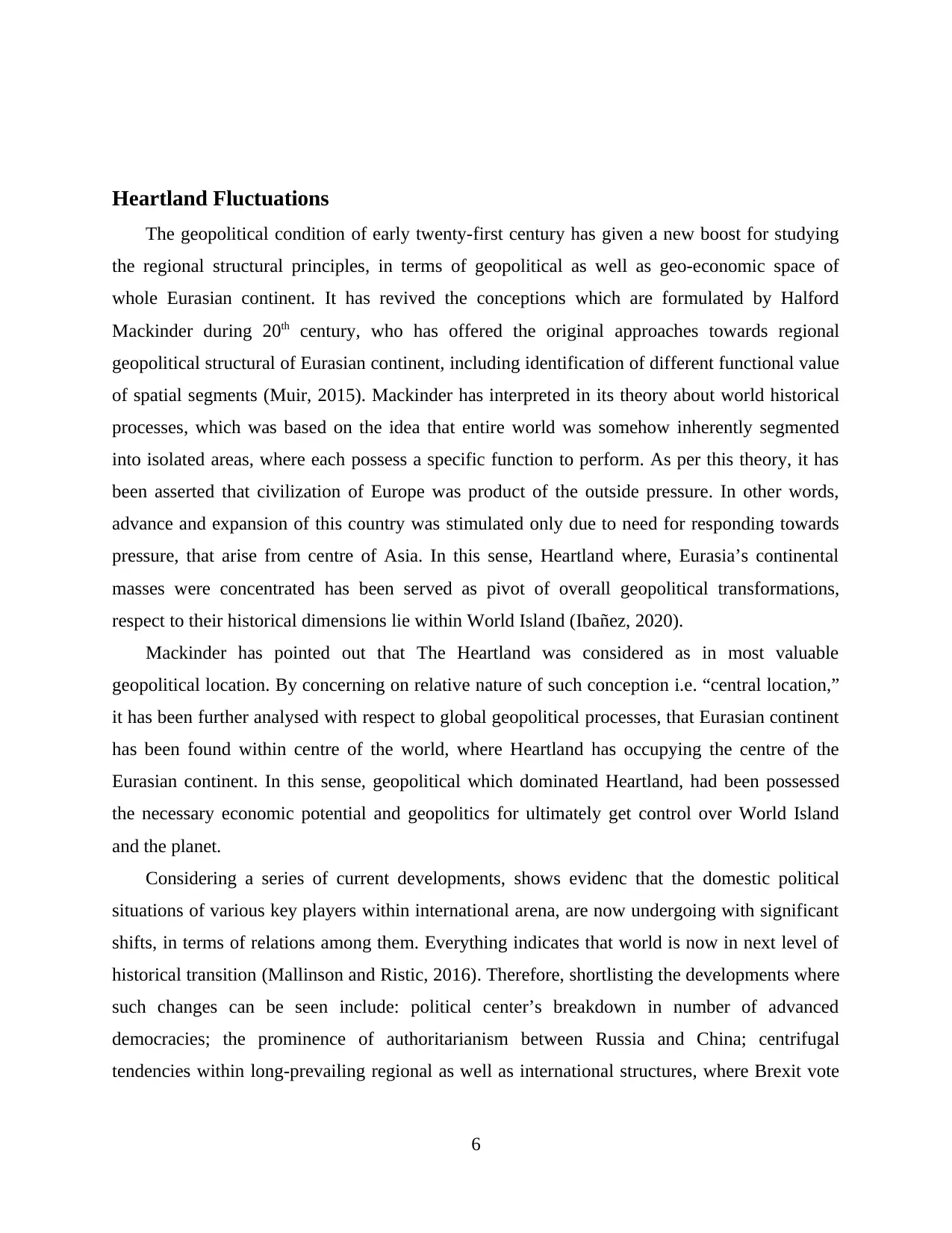
Heartland Fluctuations
The geopolitical condition of early twenty-first century has given a new boost for studying
the regional structural principles, in terms of geopolitical as well as geo-economic space of
whole Eurasian continent. It has revived the conceptions which are formulated by Halford
Mackinder during 20th century, who has offered the original approaches towards regional
geopolitical structural of Eurasian continent, including identification of different functional value
of spatial segments (Muir, 2015). Mackinder has interpreted in its theory about world historical
processes, which was based on the idea that entire world was somehow inherently segmented
into isolated areas, where each possess a specific function to perform. As per this theory, it has
been asserted that civilization of Europe was product of the outside pressure. In other words,
advance and expansion of this country was stimulated only due to need for responding towards
pressure, that arise from centre of Asia. In this sense, Heartland where, Eurasia’s continental
masses were concentrated has been served as pivot of overall geopolitical transformations,
respect to their historical dimensions lie within World Island (Ibañez, 2020).
Mackinder has pointed out that The Heartland was considered as in most valuable
geopolitical location. By concerning on relative nature of such conception i.e. “central location,”
it has been further analysed with respect to global geopolitical processes, that Eurasian continent
has been found within centre of the world, where Heartland has occupying the centre of the
Eurasian continent. In this sense, geopolitical which dominated Heartland, had been possessed
the necessary economic potential and geopolitics for ultimately get control over World Island
and the planet.
Considering a series of current developments, shows evidenc that the domestic political
situations of various key players within international arena, are now undergoing with significant
shifts, in terms of relations among them. Everything indicates that world is now in next level of
historical transition (Mallinson and Ristic, 2016). Therefore, shortlisting the developments where
such changes can be seen include: political center’s breakdown in number of advanced
democracies; the prominence of authoritarianism between Russia and China; centrifugal
tendencies within long-prevailing regional as well as international structures, where Brexit vote
6
The geopolitical condition of early twenty-first century has given a new boost for studying
the regional structural principles, in terms of geopolitical as well as geo-economic space of
whole Eurasian continent. It has revived the conceptions which are formulated by Halford
Mackinder during 20th century, who has offered the original approaches towards regional
geopolitical structural of Eurasian continent, including identification of different functional value
of spatial segments (Muir, 2015). Mackinder has interpreted in its theory about world historical
processes, which was based on the idea that entire world was somehow inherently segmented
into isolated areas, where each possess a specific function to perform. As per this theory, it has
been asserted that civilization of Europe was product of the outside pressure. In other words,
advance and expansion of this country was stimulated only due to need for responding towards
pressure, that arise from centre of Asia. In this sense, Heartland where, Eurasia’s continental
masses were concentrated has been served as pivot of overall geopolitical transformations,
respect to their historical dimensions lie within World Island (Ibañez, 2020).
Mackinder has pointed out that The Heartland was considered as in most valuable
geopolitical location. By concerning on relative nature of such conception i.e. “central location,”
it has been further analysed with respect to global geopolitical processes, that Eurasian continent
has been found within centre of the world, where Heartland has occupying the centre of the
Eurasian continent. In this sense, geopolitical which dominated Heartland, had been possessed
the necessary economic potential and geopolitics for ultimately get control over World Island
and the planet.
Considering a series of current developments, shows evidenc that the domestic political
situations of various key players within international arena, are now undergoing with significant
shifts, in terms of relations among them. Everything indicates that world is now in next level of
historical transition (Mallinson and Ristic, 2016). Therefore, shortlisting the developments where
such changes can be seen include: political center’s breakdown in number of advanced
democracies; the prominence of authoritarianism between Russia and China; centrifugal
tendencies within long-prevailing regional as well as international structures, where Brexit vote
6
⊘ This is a preview!⊘
Do you want full access?
Subscribe today to unlock all pages.

Trusted by 1+ million students worldwide
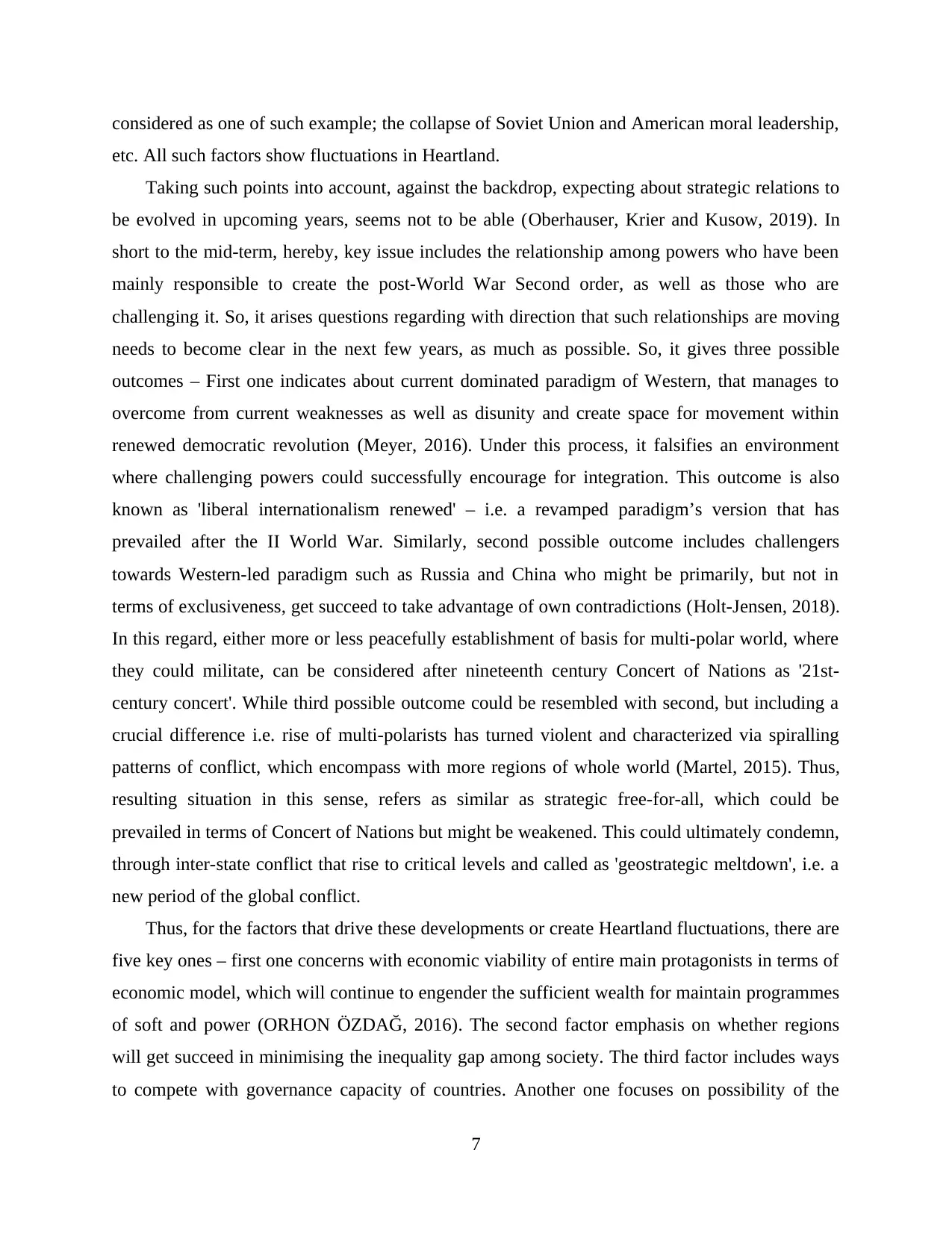
considered as one of such example; the collapse of Soviet Union and American moral leadership,
etc. All such factors show fluctuations in Heartland.
Taking such points into account, against the backdrop, expecting about strategic relations to
be evolved in upcoming years, seems not to be able (Oberhauser, Krier and Kusow, 2019). In
short to the mid-term, hereby, key issue includes the relationship among powers who have been
mainly responsible to create the post-World War Second order, as well as those who are
challenging it. So, it arises questions regarding with direction that such relationships are moving
needs to become clear in the next few years, as much as possible. So, it gives three possible
outcomes – First one indicates about current dominated paradigm of Western, that manages to
overcome from current weaknesses as well as disunity and create space for movement within
renewed democratic revolution (Meyer, 2016). Under this process, it falsifies an environment
where challenging powers could successfully encourage for integration. This outcome is also
known as 'liberal internationalism renewed' – i.e. a revamped paradigm’s version that has
prevailed after the II World War. Similarly, second possible outcome includes challengers
towards Western-led paradigm such as Russia and China who might be primarily, but not in
terms of exclusiveness, get succeed to take advantage of own contradictions (Holt-Jensen, 2018).
In this regard, either more or less peacefully establishment of basis for multi-polar world, where
they could militate, can be considered after nineteenth century Concert of Nations as '21st-
century concert'. While third possible outcome could be resembled with second, but including a
crucial difference i.e. rise of multi-polarists has turned violent and characterized via spiralling
patterns of conflict, which encompass with more regions of whole world (Martel, 2015). Thus,
resulting situation in this sense, refers as similar as strategic free-for-all, which could be
prevailed in terms of Concert of Nations but might be weakened. This could ultimately condemn,
through inter-state conflict that rise to critical levels and called as 'geostrategic meltdown', i.e. a
new period of the global conflict.
Thus, for the factors that drive these developments or create Heartland fluctuations, there are
five key ones – first one concerns with economic viability of entire main protagonists in terms of
economic model, which will continue to engender the sufficient wealth for maintain programmes
of soft and power (ORHON ÖZDAĞ, 2016). The second factor emphasis on whether regions
will get succeed in minimising the inequality gap among society. The third factor includes ways
to compete with governance capacity of countries. Another one focuses on possibility of the
7
etc. All such factors show fluctuations in Heartland.
Taking such points into account, against the backdrop, expecting about strategic relations to
be evolved in upcoming years, seems not to be able (Oberhauser, Krier and Kusow, 2019). In
short to the mid-term, hereby, key issue includes the relationship among powers who have been
mainly responsible to create the post-World War Second order, as well as those who are
challenging it. So, it arises questions regarding with direction that such relationships are moving
needs to become clear in the next few years, as much as possible. So, it gives three possible
outcomes – First one indicates about current dominated paradigm of Western, that manages to
overcome from current weaknesses as well as disunity and create space for movement within
renewed democratic revolution (Meyer, 2016). Under this process, it falsifies an environment
where challenging powers could successfully encourage for integration. This outcome is also
known as 'liberal internationalism renewed' – i.e. a revamped paradigm’s version that has
prevailed after the II World War. Similarly, second possible outcome includes challengers
towards Western-led paradigm such as Russia and China who might be primarily, but not in
terms of exclusiveness, get succeed to take advantage of own contradictions (Holt-Jensen, 2018).
In this regard, either more or less peacefully establishment of basis for multi-polar world, where
they could militate, can be considered after nineteenth century Concert of Nations as '21st-
century concert'. While third possible outcome could be resembled with second, but including a
crucial difference i.e. rise of multi-polarists has turned violent and characterized via spiralling
patterns of conflict, which encompass with more regions of whole world (Martel, 2015). Thus,
resulting situation in this sense, refers as similar as strategic free-for-all, which could be
prevailed in terms of Concert of Nations but might be weakened. This could ultimately condemn,
through inter-state conflict that rise to critical levels and called as 'geostrategic meltdown', i.e. a
new period of the global conflict.
Thus, for the factors that drive these developments or create Heartland fluctuations, there are
five key ones – first one concerns with economic viability of entire main protagonists in terms of
economic model, which will continue to engender the sufficient wealth for maintain programmes
of soft and power (ORHON ÖZDAĞ, 2016). The second factor emphasis on whether regions
will get succeed in minimising the inequality gap among society. The third factor includes ways
to compete with governance capacity of countries. Another one focuses on possibility of the
7
Paraphrase This Document
Need a fresh take? Get an instant paraphrase of this document with our AI Paraphraser
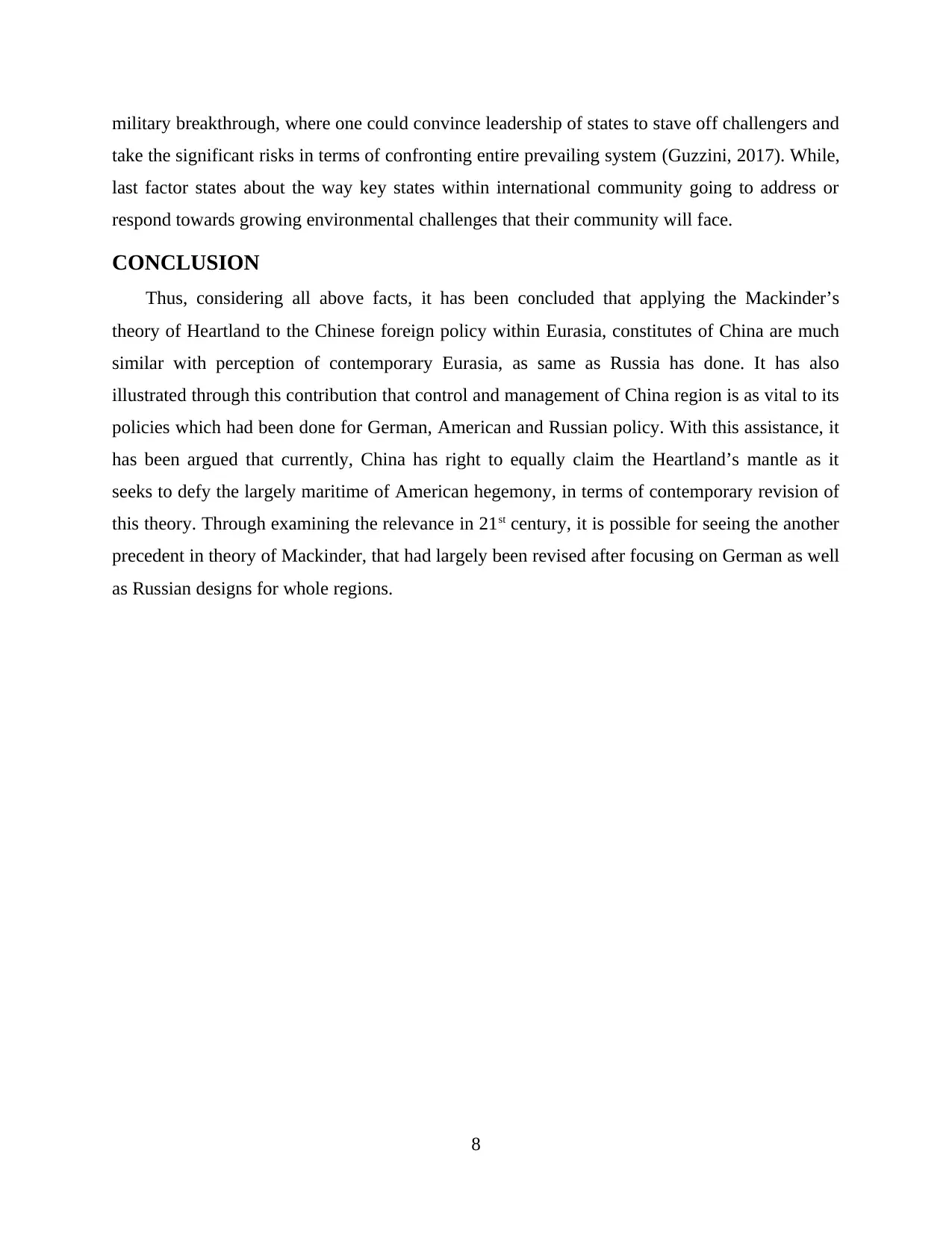
military breakthrough, where one could convince leadership of states to stave off challengers and
take the significant risks in terms of confronting entire prevailing system (Guzzini, 2017). While,
last factor states about the way key states within international community going to address or
respond towards growing environmental challenges that their community will face.
CONCLUSION
Thus, considering all above facts, it has been concluded that applying the Mackinder’s
theory of Heartland to the Chinese foreign policy within Eurasia, constitutes of China are much
similar with perception of contemporary Eurasia, as same as Russia has done. It has also
illustrated through this contribution that control and management of China region is as vital to its
policies which had been done for German, American and Russian policy. With this assistance, it
has been argued that currently, China has right to equally claim the Heartland’s mantle as it
seeks to defy the largely maritime of American hegemony, in terms of contemporary revision of
this theory. Through examining the relevance in 21st century, it is possible for seeing the another
precedent in theory of Mackinder, that had largely been revised after focusing on German as well
as Russian designs for whole regions.
8
take the significant risks in terms of confronting entire prevailing system (Guzzini, 2017). While,
last factor states about the way key states within international community going to address or
respond towards growing environmental challenges that their community will face.
CONCLUSION
Thus, considering all above facts, it has been concluded that applying the Mackinder’s
theory of Heartland to the Chinese foreign policy within Eurasia, constitutes of China are much
similar with perception of contemporary Eurasia, as same as Russia has done. It has also
illustrated through this contribution that control and management of China region is as vital to its
policies which had been done for German, American and Russian policy. With this assistance, it
has been argued that currently, China has right to equally claim the Heartland’s mantle as it
seeks to defy the largely maritime of American hegemony, in terms of contemporary revision of
this theory. Through examining the relevance in 21st century, it is possible for seeing the another
precedent in theory of Mackinder, that had largely been revised after focusing on German as well
as Russian designs for whole regions.
8
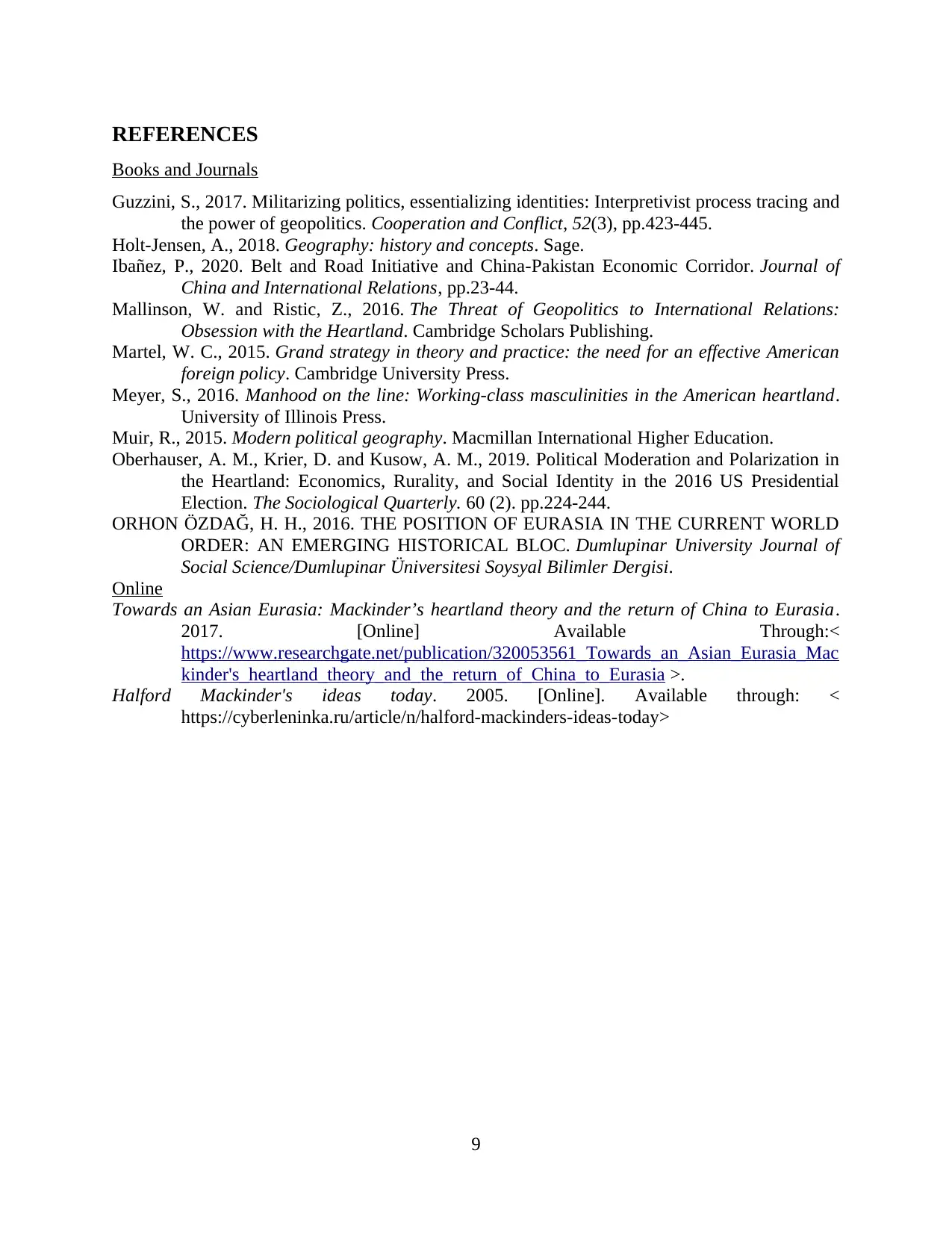
REFERENCES
Books and Journals
Guzzini, S., 2017. Militarizing politics, essentializing identities: Interpretivist process tracing and
the power of geopolitics. Cooperation and Conflict, 52(3), pp.423-445.
Holt-Jensen, A., 2018. Geography: history and concepts. Sage.
Ibañez, P., 2020. Belt and Road Initiative and China-Pakistan Economic Corridor. Journal of
China and International Relations, pp.23-44.
Mallinson, W. and Ristic, Z., 2016. The Threat of Geopolitics to International Relations:
Obsession with the Heartland. Cambridge Scholars Publishing.
Martel, W. C., 2015. Grand strategy in theory and practice: the need for an effective American
foreign policy. Cambridge University Press.
Meyer, S., 2016. Manhood on the line: Working-class masculinities in the American heartland.
University of Illinois Press.
Muir, R., 2015. Modern political geography. Macmillan International Higher Education.
Oberhauser, A. M., Krier, D. and Kusow, A. M., 2019. Political Moderation and Polarization in
the Heartland: Economics, Rurality, and Social Identity in the 2016 US Presidential
Election. The Sociological Quarterly. 60 (2). pp.224-244.
ORHON ÖZDAĞ, H. H., 2016. THE POSITION OF EURASIA IN THE CURRENT WORLD
ORDER: AN EMERGING HISTORICAL BLOC. Dumlupinar University Journal of
Social Science/Dumlupinar Üniversitesi Soysyal Bilimler Dergisi.
Online
Towards an Asian Eurasia: Mackinder’s heartland theory and the return of China to Eurasia.
2017. [Online] Available Through:<
https://www.researchgate.net/publication/320053561_Towards_an_Asian_Eurasia_Mac
kinder's_heartland_theory_and_the_return_of_China_to_Eurasia >.
Halford Mackinder's ideas today. 2005. [Online]. Available through: <
https://cyberleninka.ru/article/n/halford-mackinders-ideas-today>
9
Books and Journals
Guzzini, S., 2017. Militarizing politics, essentializing identities: Interpretivist process tracing and
the power of geopolitics. Cooperation and Conflict, 52(3), pp.423-445.
Holt-Jensen, A., 2018. Geography: history and concepts. Sage.
Ibañez, P., 2020. Belt and Road Initiative and China-Pakistan Economic Corridor. Journal of
China and International Relations, pp.23-44.
Mallinson, W. and Ristic, Z., 2016. The Threat of Geopolitics to International Relations:
Obsession with the Heartland. Cambridge Scholars Publishing.
Martel, W. C., 2015. Grand strategy in theory and practice: the need for an effective American
foreign policy. Cambridge University Press.
Meyer, S., 2016. Manhood on the line: Working-class masculinities in the American heartland.
University of Illinois Press.
Muir, R., 2015. Modern political geography. Macmillan International Higher Education.
Oberhauser, A. M., Krier, D. and Kusow, A. M., 2019. Political Moderation and Polarization in
the Heartland: Economics, Rurality, and Social Identity in the 2016 US Presidential
Election. The Sociological Quarterly. 60 (2). pp.224-244.
ORHON ÖZDAĞ, H. H., 2016. THE POSITION OF EURASIA IN THE CURRENT WORLD
ORDER: AN EMERGING HISTORICAL BLOC. Dumlupinar University Journal of
Social Science/Dumlupinar Üniversitesi Soysyal Bilimler Dergisi.
Online
Towards an Asian Eurasia: Mackinder’s heartland theory and the return of China to Eurasia.
2017. [Online] Available Through:<
https://www.researchgate.net/publication/320053561_Towards_an_Asian_Eurasia_Mac
kinder's_heartland_theory_and_the_return_of_China_to_Eurasia >.
Halford Mackinder's ideas today. 2005. [Online]. Available through: <
https://cyberleninka.ru/article/n/halford-mackinders-ideas-today>
9
⊘ This is a preview!⊘
Do you want full access?
Subscribe today to unlock all pages.

Trusted by 1+ million students worldwide
1 out of 12
Related Documents
Your All-in-One AI-Powered Toolkit for Academic Success.
+13062052269
info@desklib.com
Available 24*7 on WhatsApp / Email
![[object Object]](/_next/static/media/star-bottom.7253800d.svg)
Unlock your academic potential
Copyright © 2020–2025 A2Z Services. All Rights Reserved. Developed and managed by ZUCOL.





